Books by Anna Szabolcsi
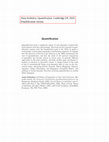
Quantification forms a significant aspect of cross-linguistic research into both sentence structu... more Quantification forms a significant aspect of cross-linguistic research into both sentence structure and meaning. This book surveys research in quantification starting with the foundational work in the 1970s. It paints a vivid picture of generalized quantifiers and Boolean semantics. It explains how the discovery of diverse scope behavior in the 1990s transformed the view of quantification, and how the study of the internal composition of quantifiers has become central in recent years. It presents different approaches to the same problems, and links modern logic and formal semantics to advances in generative syntax. A unique feature of the book is that it systematically brings cross-linguistic data to bear on the theoretical issues, discussing French, German, Dutch, Hungarian, Russian, Japanese, Telugu (Dravidian), and Shupamem (Grassfield Bantu), and pointing to formal semantic literature involving quantification in around thirty languages.
" Linguistics: An Introduction to Linguistic Theory ... more " Linguistics: An Introduction to Linguistic Theory is a textbook, written for introductory courses in linguistic theory for undergraduate linguistics majors and first year graduate students. Twelve major figures in the field bring their expertise to each of the core areas of the field morphology, syntax, semantics, phonetics, phonology, and language acquisition.
Ways of Scope Taking, 1997
newer 2000-- by Anna Szabolcsi

NegLaB workshop , 2024
In seminal work, Zeijlstra has proposed that the sentential negative marker in strict negative co... more In seminal work, Zeijlstra has proposed that the sentential negative marker in strict negative concord languages is a meaningless particle (uNeg) that invokes a silent negative operator (iNeg) at the periphery. Negative concord items (NCI) are also supposed to have uNeg.
This paper puts forth new arguments to the effect that the Hungarian negative marker NEM has uNeg, but NCIs do not. Their relation to negation is indirect; they are existentials that need to be exhaustified, which in turn requires an intervening negation to maintain logical coherence (Chierchia 2013). This eliminates the appearance of redundancy in the negative marker co-occurring with NCIs.
The analysis combines features of Zeijlstra's proposal for strict NC and Chierchia's proposal for non-strict NC. Hungarian is a true NC hybrid that has an overt counterpart (SEM) of Chierchia's NEG. Hybridity proves that these features can coexist.
Theoretical Linguistics 50, 2024
This paper highlights a small selection of cases where cross-linguistic insights have been import... more This paper highlights a small selection of cases where cross-linguistic insights have been important to big questions in the theory of semantics and the syntax/semantics interface. The selection includes (i) the role and representation of Speaker and Addressee in the grammar; (ii) mismatches between form and interpretation motivating high-placed silent operators for functional elements; and (iii) the explanation of semantic universals, including universals pertaining to inventories, in terms of learnability and the trade-off between informativeness and simplicity.
Glossa, 2021
According to the classical description of obviation, the subject of a subjunctive is disjoint in ... more According to the classical description of obviation, the subject of a subjunctive is disjoint in reference from the attitude-holder subject of the immediately higher clause.
*Je veux que je parte.
I want that I leave.SUBJ
‘I want for me to leave’
Inspired by Ruwet (1984/1991) and Farkas (1988; 1992), I present data from Hungarian where obviation in certain subjunctives is plainly lifted, and data where obviation occurs in indicatives. I argue that obviation is not the result of competition with another construction, and point to promising potential accounts in terms of a clash in semantics or pragmatics. My aim is to contribute desiderata for a theory of obviation and exemptions from obviation in fairly informal terms.
Általános Nyelvészeti Tanulmányok XXXII, 2020
This paper points out naturally-occurring examples, primarily in Hungarian but also to a more lim... more This paper points out naturally-occurring examples, primarily in Hungarian but also to a more limited extent in English, in which disjunction (i) has a conjunctive force but (ii) its use highlights that the list is not intended to be exhaustive. The preliminary analysis is in terms of recursive proposition strengthening by exhaustification without a scalar alternative, assimilating exemplifications to known cases of conjunctively interpreted disjunctions in other languages.
Semantics and Linguistic Theory 29, 2019
Rawlins (2013: 160) observes that both unconditionals and more classical free choice can be meta-... more Rawlins (2013: 160) observes that both unconditionals and more classical free choice can be meta-characterized using orthogonality, but does not actually unify the two. One reason may be that in English, different expressions serve in these roles. By contrast, in Hungarian, AKÁR expressions serve as NPIs, FCIs, and unconditional adjuncts, but not as interrogatives or free relatives. This paper offers a unified account of the Hungarian data, extending Chierchia 2013 and Dayal 2013. The account produces the same unconditional meanings that Rawlins derives from an interrogative basis. This result highlights the fact that sets of alternatives arise from different morpho-syntactic sources and are utilized by the grammar in different ways, but the results may fully converge.
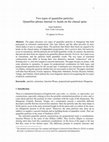
Glossa 3(1) #69, 2018
The paper discusses two types of quantifier particles in Hungarian that both participate in reite... more The paper discusses two types of quantifier particles in Hungarian that both participate in reiterated constructions. One type follows and the other precedes its host, which makes it easy to compare them. The particles that follow their hosts are argued to be heads on the clausal spines of independent propositions. Host+particle does, but need not, occur in reiterations, and the particles do not build quantifier words. In contrast, the particles that precede their hosts are argued to be quantifier-phrase internal. Particle+host must occur in reiterations, and the particles build quantifier words. The two types of reiterated constructions also differ in having their own distinctive internal "connectives" and in forming strict vs. non-strict negative concord expressions. The paper focuses on syntax, with some attention to semantics. It argues for propositional coordination for both types, and propositional quantification for the second type. Constituent-size reiterations are derivable via ellipsis, raising the question whether they are necessarily so derived. The paper concludes with data from Bosnian, French, Japanese, Malayalam, Mandarin, Persian, Russian, Sinhala, Telugu, and Turkish, which indicate the cross-linguistic interest of recognizing the two types of particle constructions.
Bartos et al. eds. Boundaries Crossed... (Springer), 2018
Surányi (2006) observed that Hungarian has a hybrid (strict + non-strict) negative concord system... more Surányi (2006) observed that Hungarian has a hybrid (strict + non-strict) negative concord system. This paper proposes a unified analysis of that system within the general framework of Zeijlstra (2004, 2008) and, especially, Chierchia (2013), with the following new ingredients. Sentential negation nem is the same full negation in the presence of both strict and non-strict concord items. Preverbal senkìn-one' type negative concord items occupy the specifier position of either nem`not' or sem`nor'. The latter, sem spells out is`too, even' in the immediate scope of negation; is/sem are focus-associating heads on the clausal spine. Sem can be seen as an overt counterpart of the phonetically null head that Chierchia dubs NEG; it is capable of invoking an abstract (disembodied) negation at the edge of its projection.
Proceedings of Amsterdam Colloquium 2017
The additive presupposition of particles like too/even is uncontested, but usually stipulated. Th... more The additive presupposition of particles like too/even is uncontested, but usually stipulated. This paper proposes to derive it based on two properties. (i) too/even is cross-linguistically focus-sensitive, and (ii) in many languages, too/even builds negative polarity items and free-choice items as well, often in concert with other particles. (i) is the source of its existential presupposition, and (ii) offers clues regarding how additivity comes about. (i)-(ii) together demand a sparse semantics for too/even, one that can work with different kinds of alternatives (focus, subdomain, scalar) and invoke suitably different further operators.
Carlson (1983, 2006) observes that functional elements often present mismatches in form and inter... more Carlson (1983, 2006) observes that functional elements often present mismatches in form and interpretation that lexical elements do not.
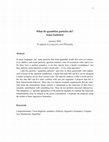
Linguistics and Philosophy, 2015
In many languages, the same particles that form quantifier words also serve as connectives, ad... more In many languages, the same particles that form quantifier words also serve as connectives, additive and scalar particles, question markers, roots of existential verbs, and so on. Do these have a unified semantics, or do they merely bear a family resemblance? Are they aided by silent operators in their varied roles -- if yes, what operators?
I dub the particles “quantifier particles” and refer to them generically with capitalized versions of the Japanese morphemes. I argue that both MO and KA can be assigned a stable semantics across their various roles. The specific analysis I offer is motivated by the fact that MO and KA often combine with just one argument; I propose that this is their characteristic behavior. Their role is to impose semantic requirements that are satisfied when the immediately larger context is interpreted as the meet/join of their host’s semantic contribution with something else. They do not perform meet/join themselves. The obligatory vs. optional appearance of the particles depends on whether the meet/join interpretations arise by default in the given constellation. I explicate the proposal using the toolkit of basic Inquisitive Semantics.
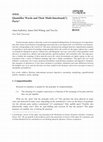
Formal semantic analyses often take words to be minimal building blocks for the purposes of compo... more Formal semantic analyses often take words to be minimal building blocks for the purposes of compositionality. But various recent theories of morphology and syntax have converged on the view that there is no demarcation line corresponding to the word level. The same conclusion has emerged from the compositional semantics of superlatives. In the spirit of extending compositionality below the word level, this paper explores how a small set of particles (Japanese ka and mo, Chinese dou, and Hungarian vala/vagy, mind, and is) form quantifier words and serve as connectives, additive and scalar particles, question markers, and existential verbs. Our main question is whether the meanings of these particles across the varied environments are highly regular, or they are lexicalized with a variety of different meanings that bear a family resemblance. This paper does not reach definitive conclusions, but it raises analytical possibilities using Boolean semantics and Inquisitive Semantics (the semantics of alternatives). It also draws attention to systematic similarities and some differences between the multiple uses of mo and dou that have not been studied in the literature, and reviews accounts in terms of maximality and additivity.
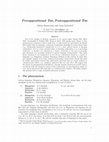
Festschrift for Groenendijk, Stokhof & Veltman
One of the insights of dynamic semantics in its various guises (Kamp 1981, Heim
1982, Groenendij... more One of the insights of dynamic semantics in its various guises (Kamp 1981, Heim
1982, Groenendijk & Stokhof 1991, Kamp & Reyle 1993 among many others) is that
interpretation is sensitive to left-to-right order. Is order sensitivity, particularly the default left-to-right order of evaluation, a property of particular meanings of certain lexical items (e.g., dynamically interpreted conjunction) or is it a more general feature of meaning composition? If it is a more general feature of meaning composition, is it a processing ‘preference’ or should it be captured as a ‘harder’ constraint on the type of meanings and operations over meanings involved in natural language interpretation? This squib draws attention to the symmetrical A-too B-too construction (found in a variety of languages, e.g., Hungarian, Japanese, Romanian, Russian) in this context. It argues that any semantic analysis of its main ‘symmetrical-meaning’ characteristic should also allow for subtler interactions between this construction and items that are clearly sensitive to evaluation-order effects, e.g., anaphoric adjectives like next and other. We suggest that the notion of postsupposition embedded in a broader dynamic framework is better able to account for both the symmetric nature of this construction, its non-symmetric variant A-too, and its interaction with items that are evaluation-order sensitive. We briefly compare this proposal with a couple of possible alternative accounts.
AC 2013 Proceedings
In many languages, the same particles build quantifier words and serve as connectives, additive a... more In many languages, the same particles build quantifier words and serve as connectives, additive and scalar particles, question markers, existential verbs, and so on. Do the roles of each particle form a natural class with a stable semantics? Are the particles aided by additional elements, overt or covert, in fulfilling their varied roles? I propose a unified analysis, according to which the particles impose partial ordering requirements (glb and lub) on the interpretations of their hosts and the immediate larger contexts, but do not embody algebraic operations themselves.
Language, 2013
Mauritian Creole (MC) is a French lexifier creole with Kwa and Bantu substrate languages. In the ... more Mauritian Creole (MC) is a French lexifier creole with Kwa and Bantu substrate languages. In the early nineteenth century MC lost the French determiners le/la 'the' and du (partitive 'some'), often incorporating them into the noun stems, and became, in stark contrast to French, a language that allows bare count and mass nouns in argument positions. Diana Guillemin's book is dedicated to the documentation and theoretical analysis of that change, as well as the new system of determiners and quantifiers that subsequently emerged in MC. G is a native speaker of MC, but the study is primarily corpus-based, with over eighty text sources, ranging from eighteenthcentury documents to Baissac's ( , 1888 collections to recent internet posts. The analysis is carried out using current formal semantic and generative syntactic theories.

The Wiley Blackwell Companion to Syntax, 2nd ed., 2017
The focus of the chapter is weak islands (WI), i.e. selective islands. Strong (absolute) islands ... more The focus of the chapter is weak islands (WI), i.e. selective islands. Strong (absolute) islands are considered only to set the stage for the discussion of WIs. Up until the late 1980s nothing much beyond wh-islands had been thought to be a WI. Beginning with Relativized Minimality, an ever-growing range of WIs has been recognized. Thus, theories of weak islands have mushroomed, each coming with a significant set of new data and important new connections to other domains. The chapter emphasizes the correspondence between data sets and theories. Less attention is given to proposals that primarily recast the theoretical account of some narrow range of data.
Section 2 explains the distinction between absolute versus selective islands. Section 3 introduces a range of classical strong islands and various types of explanations, among them subjacency, repair by ellipsis, and processing. Sections 4, 5, and 6 enumerate the kind of extractions that are sensitive to WIs and the factors that induce a WI. Under the rubric of weak-island sensitivity, it discusses arguments vs. adjuncts, referential or existentially presupposing vs. non-referential expression, D-linking, individual vs. non-individual expressions and how many-phrases, functional readings and event-related readings, split constructions, negative polarity licensing, and cross-sentential anaphora. Under the rubric of weak-island inducers, it considers intervention effects due to wh-islands, negatives and other affective operators, response stance and non-stance in contrast to volunteered stance predicates, extraposition islands, VP-adverbs, and finally quantifier scope islands. Section 7 is devoted to various theories of islands, starting with ECP and subjacency, moving on to Relativized Minimality. Theoretical problems and the diversity of the data motivate the transition to the scope theory that comes in two versions, the algebraic semantic and the dynamic semantic ones. Section 8 concludes.










Uploads
Books by Anna Szabolcsi
newer 2000-- by Anna Szabolcsi
This paper puts forth new arguments to the effect that the Hungarian negative marker NEM has uNeg, but NCIs do not. Their relation to negation is indirect; they are existentials that need to be exhaustified, which in turn requires an intervening negation to maintain logical coherence (Chierchia 2013). This eliminates the appearance of redundancy in the negative marker co-occurring with NCIs.
The analysis combines features of Zeijlstra's proposal for strict NC and Chierchia's proposal for non-strict NC. Hungarian is a true NC hybrid that has an overt counterpart (SEM) of Chierchia's NEG. Hybridity proves that these features can coexist.
*Je veux que je parte.
I want that I leave.SUBJ
‘I want for me to leave’
Inspired by Ruwet (1984/1991) and Farkas (1988; 1992), I present data from Hungarian where obviation in certain subjunctives is plainly lifted, and data where obviation occurs in indicatives. I argue that obviation is not the result of competition with another construction, and point to promising potential accounts in terms of a clash in semantics or pragmatics. My aim is to contribute desiderata for a theory of obviation and exemptions from obviation in fairly informal terms.
I dub the particles “quantifier particles” and refer to them generically with capitalized versions of the Japanese morphemes. I argue that both MO and KA can be assigned a stable semantics across their various roles. The specific analysis I offer is motivated by the fact that MO and KA often combine with just one argument; I propose that this is their characteristic behavior. Their role is to impose semantic requirements that are satisfied when the immediately larger context is interpreted as the meet/join of their host’s semantic contribution with something else. They do not perform meet/join themselves. The obligatory vs. optional appearance of the particles depends on whether the meet/join interpretations arise by default in the given constellation. I explicate the proposal using the toolkit of basic Inquisitive Semantics.
1982, Groenendijk & Stokhof 1991, Kamp & Reyle 1993 among many others) is that
interpretation is sensitive to left-to-right order. Is order sensitivity, particularly the default left-to-right order of evaluation, a property of particular meanings of certain lexical items (e.g., dynamically interpreted conjunction) or is it a more general feature of meaning composition? If it is a more general feature of meaning composition, is it a processing ‘preference’ or should it be captured as a ‘harder’ constraint on the type of meanings and operations over meanings involved in natural language interpretation? This squib draws attention to the symmetrical A-too B-too construction (found in a variety of languages, e.g., Hungarian, Japanese, Romanian, Russian) in this context. It argues that any semantic analysis of its main ‘symmetrical-meaning’ characteristic should also allow for subtler interactions between this construction and items that are clearly sensitive to evaluation-order effects, e.g., anaphoric adjectives like next and other. We suggest that the notion of postsupposition embedded in a broader dynamic framework is better able to account for both the symmetric nature of this construction, its non-symmetric variant A-too, and its interaction with items that are evaluation-order sensitive. We briefly compare this proposal with a couple of possible alternative accounts.
Section 2 explains the distinction between absolute versus selective islands. Section 3 introduces a range of classical strong islands and various types of explanations, among them subjacency, repair by ellipsis, and processing. Sections 4, 5, and 6 enumerate the kind of extractions that are sensitive to WIs and the factors that induce a WI. Under the rubric of weak-island sensitivity, it discusses arguments vs. adjuncts, referential or existentially presupposing vs. non-referential expression, D-linking, individual vs. non-individual expressions and how many-phrases, functional readings and event-related readings, split constructions, negative polarity licensing, and cross-sentential anaphora. Under the rubric of weak-island inducers, it considers intervention effects due to wh-islands, negatives and other affective operators, response stance and non-stance in contrast to volunteered stance predicates, extraposition islands, VP-adverbs, and finally quantifier scope islands. Section 7 is devoted to various theories of islands, starting with ECP and subjacency, moving on to Relativized Minimality. Theoretical problems and the diversity of the data motivate the transition to the scope theory that comes in two versions, the algebraic semantic and the dynamic semantic ones. Section 8 concludes.
This paper puts forth new arguments to the effect that the Hungarian negative marker NEM has uNeg, but NCIs do not. Their relation to negation is indirect; they are existentials that need to be exhaustified, which in turn requires an intervening negation to maintain logical coherence (Chierchia 2013). This eliminates the appearance of redundancy in the negative marker co-occurring with NCIs.
The analysis combines features of Zeijlstra's proposal for strict NC and Chierchia's proposal for non-strict NC. Hungarian is a true NC hybrid that has an overt counterpart (SEM) of Chierchia's NEG. Hybridity proves that these features can coexist.
*Je veux que je parte.
I want that I leave.SUBJ
‘I want for me to leave’
Inspired by Ruwet (1984/1991) and Farkas (1988; 1992), I present data from Hungarian where obviation in certain subjunctives is plainly lifted, and data where obviation occurs in indicatives. I argue that obviation is not the result of competition with another construction, and point to promising potential accounts in terms of a clash in semantics or pragmatics. My aim is to contribute desiderata for a theory of obviation and exemptions from obviation in fairly informal terms.
I dub the particles “quantifier particles” and refer to them generically with capitalized versions of the Japanese morphemes. I argue that both MO and KA can be assigned a stable semantics across their various roles. The specific analysis I offer is motivated by the fact that MO and KA often combine with just one argument; I propose that this is their characteristic behavior. Their role is to impose semantic requirements that are satisfied when the immediately larger context is interpreted as the meet/join of their host’s semantic contribution with something else. They do not perform meet/join themselves. The obligatory vs. optional appearance of the particles depends on whether the meet/join interpretations arise by default in the given constellation. I explicate the proposal using the toolkit of basic Inquisitive Semantics.
1982, Groenendijk & Stokhof 1991, Kamp & Reyle 1993 among many others) is that
interpretation is sensitive to left-to-right order. Is order sensitivity, particularly the default left-to-right order of evaluation, a property of particular meanings of certain lexical items (e.g., dynamically interpreted conjunction) or is it a more general feature of meaning composition? If it is a more general feature of meaning composition, is it a processing ‘preference’ or should it be captured as a ‘harder’ constraint on the type of meanings and operations over meanings involved in natural language interpretation? This squib draws attention to the symmetrical A-too B-too construction (found in a variety of languages, e.g., Hungarian, Japanese, Romanian, Russian) in this context. It argues that any semantic analysis of its main ‘symmetrical-meaning’ characteristic should also allow for subtler interactions between this construction and items that are clearly sensitive to evaluation-order effects, e.g., anaphoric adjectives like next and other. We suggest that the notion of postsupposition embedded in a broader dynamic framework is better able to account for both the symmetric nature of this construction, its non-symmetric variant A-too, and its interaction with items that are evaluation-order sensitive. We briefly compare this proposal with a couple of possible alternative accounts.
Section 2 explains the distinction between absolute versus selective islands. Section 3 introduces a range of classical strong islands and various types of explanations, among them subjacency, repair by ellipsis, and processing. Sections 4, 5, and 6 enumerate the kind of extractions that are sensitive to WIs and the factors that induce a WI. Under the rubric of weak-island sensitivity, it discusses arguments vs. adjuncts, referential or existentially presupposing vs. non-referential expression, D-linking, individual vs. non-individual expressions and how many-phrases, functional readings and event-related readings, split constructions, negative polarity licensing, and cross-sentential anaphora. Under the rubric of weak-island inducers, it considers intervention effects due to wh-islands, negatives and other affective operators, response stance and non-stance in contrast to volunteered stance predicates, extraposition islands, VP-adverbs, and finally quantifier scope islands. Section 7 is devoted to various theories of islands, starting with ECP and subjacency, moving on to Relativized Minimality. Theoretical problems and the diversity of the data motivate the transition to the scope theory that comes in two versions, the algebraic semantic and the dynamic semantic ones. Section 8 concludes.